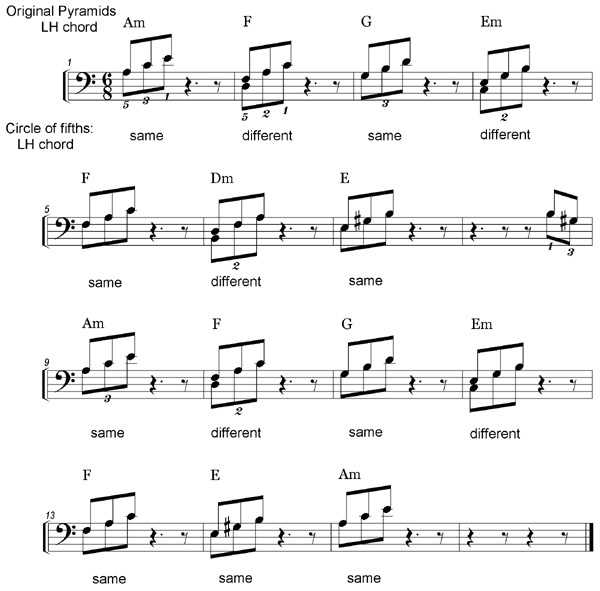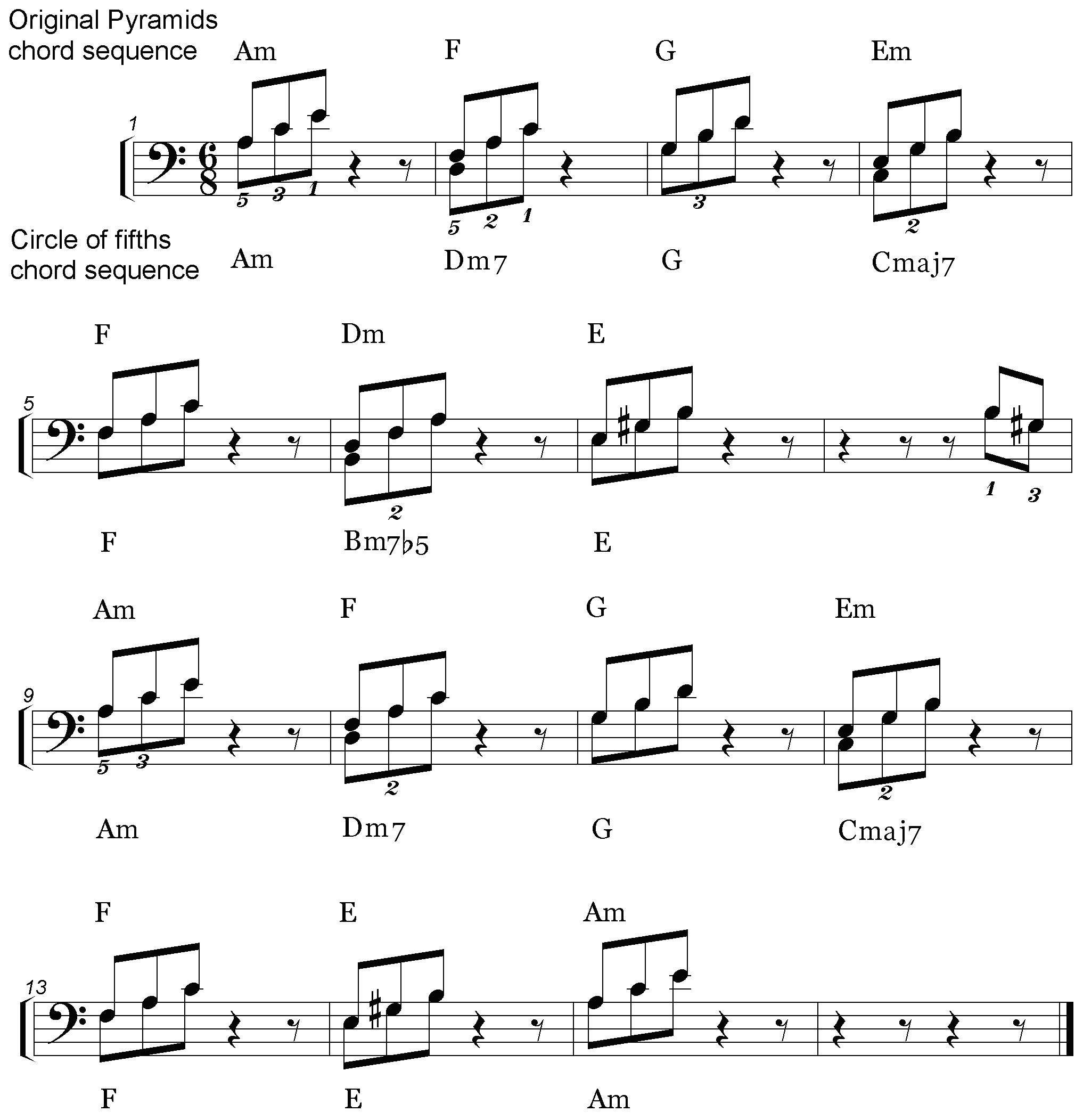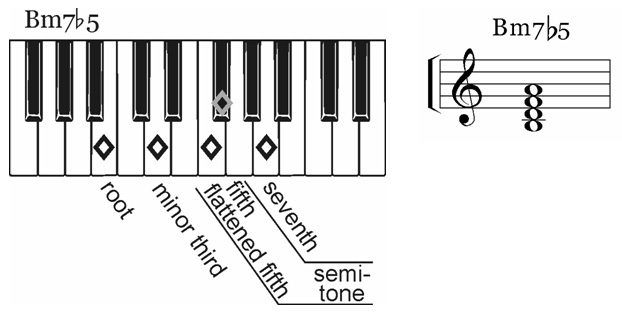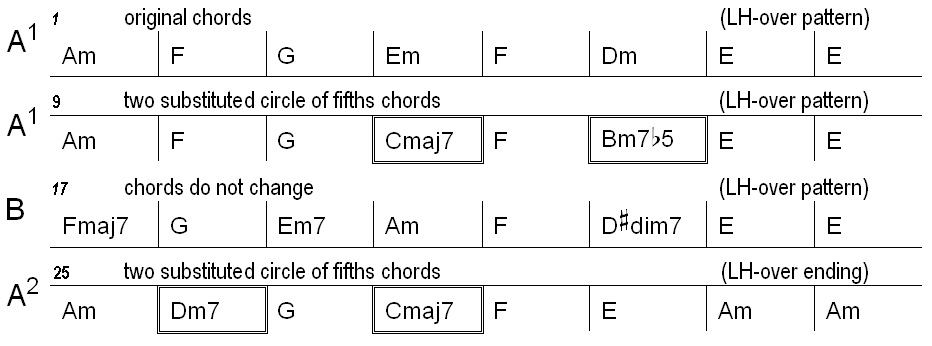The Pyramids Variations
Pyramids with the Circle of Fifths
The circle of fifths is the most powerful chord sequence in Western harmony. You cannot study popular music harmony for long without learning about it. You will recognise it when you hear it, and once you know about it, you will hear it in music all the time.
Here's an audio performance of Pyramids with circle-of-fifths chord changes.
Here is the scrolling MS module video performance.
Adapting the Pyramids bass line
The Pyramids bass line can easily be adapted to show the circle of fifths in action by lowering every other note an additional third. Look at the bass line of Pyramids as we have played it so far.
(The audio file covers both examples.)

This is the zigzag line of bass notes you have seen in many diagrams. The bass note falls a third then rises a second. Nine of the thirteen chord changes in Pyramids (underlined in the example above) follow this pattern.
Now compare the new circle of fifths bass line.

Instead of falling a third then rising a second, the bass note now falls a fifth or rises a fourth. (Falling a fifth and rising a fourth both get you to a note of the same name.) All but one of the chord changes follow the new pattern.
Adapting the Pyramids chord sequence
To adapt the Pyramids left hand part to show the circle of fifths, we only need to change five bass notes in a 16-bar A1A2 version.
The next music example shows the ‘old’ left hand version with the stems up, plus the ‘new’ circle of fifths version with the stems down, both on the same stave. You will play stems-down notes to create the new version. Notice the five bars that are different.

At this point, using the down-stem music above for the left hand, and any right hand Pyramids music, you could play a 16-bar A1A2 version Pyramids which incorporates the circle of fifths. Here are the first four bars of a simple-melody circle of fifths version. Try to complete it, comparing how it sounds to the original version.

The Pyramids circle of fifths chord sequence
Of course, if we change the bottom note of a left hand Pyramids chord, we will have changed the root, and therefore the chord will have a new name.

These new chords are called seventh chords. Here are all the seventh chords in the Pyramids circle of fifths version. The shaded diamond marks the old root.
Dmin7 (bars 2 and 10)

Key: L = LH chord R = RH chord M = melody note
Cmaj7 (bars 4 and 12)

Bm7ë5 (bar 6)

You already know major and minor seventh chords from the 'B section'.
The Bm7ë5 (B minor seven flat five) chord is the only new type of chord here. It looks like a D minor chord with B in the bass.

Previous versions of Pyramids and the circle of fifths
It’s easy to over-use the circle of fifths. For practice, play the Pyramids version on page 116 of the Workbook, which uses all the possible circle of fifths chords. Then play the versions shown in the chord charts on this page, which use only some of the possible circle of fifths chords.
In a way, versions with fewer circle of fifths chords sound more sophisticated than ones that use every possible circle of fifths chord.

A 32-bar AABA version incorporating the circle of fifths might look like this.

Now go on to the Suspensions module.
|
OUT NOW! |
THE MUSICARTA BEAT & RHYTHM WORKBOOK At last! An effective approach to keyboard rhythm & syncopation skills. Learn more! |
ONLY $24.95! |
PYRAMIDS
|
The MusicartaA methodical approach to keyboard syncopation for
|
PUBLICATIONS
exciting keyboard
creativity courses
CHORDS 101
WORKBOOK

~HANON~
video course

Musicarta
Patreon
PENTATONICS
WORKBOOK
video course

Creative Keyboard
video course

BEAT AND RHYTHM
WORKBOOK

- Volume 1 -

12-BAR PIANO
STYLES WORKBOOK

MUSICARTA MODES
WORKBOOK

PIANO STYLE

CANON PROJECT
video course

VARIATIONS
video course


- Piano Solo -
video course

- Piano Solo -


YouTube playlists





 THE LOGO
THE LOGO
